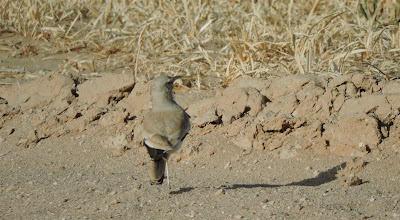The cornerstone of this approach is to keep visiting Dowkah farm on Friday mornings. This evolves a 4.30am start from Salalah arriving there around 6.30- 6.45am. I have been visiting other venues in the desert too but Dowkah is the best prospect.
Last Friday was my third consecutive Friday trip there.
This time I saw 40 species though unfortunately none were new to my country list.
I like the picture below taken towards the end of the morning. It shows five species on one part of a pivot bar. To me it symbolises the potential of this farm which has produced many rarities for birders over the years. I just have to be patient and persistent.
On the bar are: rosy starling, hoopoe, Eurasian collared dove, European turtle dove and house sparrow.
five species on a bar
rufous bush robin
One of the first birds I saw was a rufous bush robin. Another very early one was a desert wheatear which is a winter visitor to Oman. There will be many more arriving in the next few weeks. Several spotted flycatcher were perched on pivot bars.
Montagu's harrier
hoopoe lark
As usual I headed towards the cluster of palms and bushes next. On the way I spotted several black-crowned sparrow-lark and hoopoe lark.
spotted flycatcher
Arriving at the bushes, the shear numbers of spotted flycatcher was immediately apparent. There were fifty in this area and over 70 on the farm as a whole.
Turkestan shrike
Red-tailed shrikes were more plentiful too. Most were also in this shaded patch. I counted 14 Turkestan shrike and 8 Daurian shrike in the farm as a whole.
common whitethroat
common cuckoo
This time notable birds included a female common cuckoo, a group of juvenile rosy starling and a couple of golden oriole.
young rosy starling
The shaded area has still not given me any new additions to my Oman list despite it excellent reputation for rare migrants. One day it will deliver.
After the bushes I visited the nearest field which heavily watered as it was the week before. Yellow wagtail were there again but this time there was also a white wagtail.
Though white wagtail are common in winter in southern Oman, this bird was seriously early. I didnt see one until mid october last year.
white wagtail
The photo at the top of this blog showing five different species was taken in this field.
Moving on to the two fields next to the farm house and I was still picking up new species for the day.
European roller
I met my first European roller of the autumn.
glossy ibis
Last week's glossy ibis were met again assuming they were the same birds.
red-backed shrike
Inspecting the pivot bar added two more birds for the day. Two red-backed shrike were seen and on the same bar as one of them was a rock thrush.
common rock thrush
I doubled back to the large pool where I had seen the glossy ibis. The reason was that I saw a gull land and you don't often see large black-headed gulls away from the coast.
Heuglin's gull
It was a Heuglin's gull. It took water to drink and a short rest then flew off south presumably heading for the Dhofari coast.
Paying more attention to the pool this time and it became obvious that it was a magnet for the small number of waders travelling this way.
ruff
Other waders included green sandpiper, common sandpiper, marsh sandpiper and common snipe.
marsh sandpiper (left)
I finally had to leave Dawkah farm because of the heat.
Having rested in the car, I stopped off briefly at Al Beed farm on the way back.
This farm is smaller than Dowkah farm and birds can be more hit or miss.
golden oriole at Al Beed farm
There were a few spotted flycatcher, rufous bush robin, common whitethroat and golden oriole but nothing not seen at Dowkah.
Finally I stopped speculatively in the town of Thumrait looking for any green parkland.
I came across a brand new area which has been recently planted with grass and a few bushes. It is clearly going to be a major park.
tree pipit at Thumrait
Here I saw my first tree pipit of the autumn though the most abundant birds were European collared dove and black-crowned sparrow-lark.
tree pipit at Thumrait 2
the new park at Thumrait
I have been birding again during the mid-week in the Salalah area. I will blog about this next.






















nice birding..strangly this year still did not see any european nightjar..normaly i saw them mid august in sohar oman..have you come across any in salalh this season starting..
ReplyDeletecan i get your email id please..so i can send you pic for bird ID..
best regards
jignesh
This comment has been removed by the author.
ReplyDelete